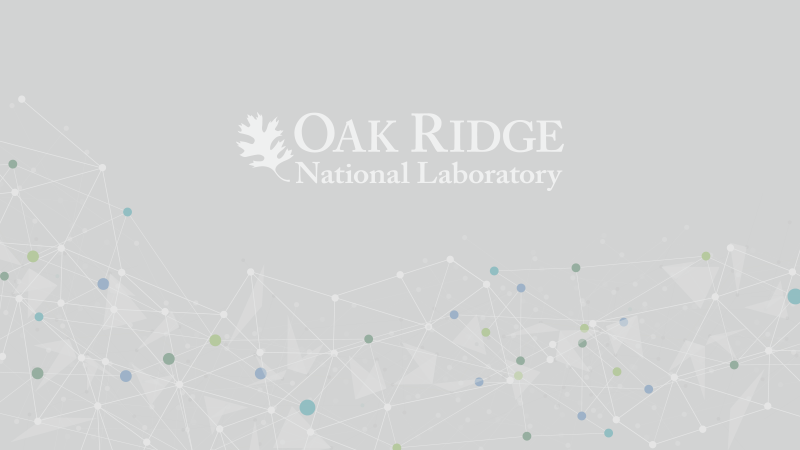Protons (positive hydrogen ions) in an ice lattice have been “seen” to fast hop from one water molecule to another, using quasi-elastic neutron scattering at the SNS Backscattering Spectrometer, BASIS. This fundamental phenomenon that occurs at very low temperatures has important consequences for future investigations of proton conductivity in solids. The research could open the door to a new understanding of how electrolytes work in a system.
Proton hopping in ice occurs when “extra” protons diffuse through molecules of water, forming new covalent bonds with adjacent water molecules. When an extra proton joins an existing water molecule, composed of one oxygen and two hydrogens, the molecule is destabilized, then rotates and expels one of its three hydrogens. The expelled proton jumps to an adjacent water molecule, which becomes destabilized in turn. The hopping process, repeating itself across the crystalline ice lattice, produces proton conductivity through the solid.
To confirm this phenomenon, Daniel Huppert of Tel Aviv University and collaborators at Argonne National Laboratory and ORNL used BASIS to study a sample of ice doped with diluted hydrochloric acid (HCl) by quasi-elastic neutron scattering. The HCl is used to provide extra protons to initiate the hopping phenomenon.
The researchers studied the effect of HCl adsorption on bulk ice Ih in the temperature range of 140 to 195 K (-133.15 to -78.15ºC).
“The experiment is very simple,” explains Alexander Kolesnikov, an instrument scientist at ORNL who collaborated on the experiment. “We prepared two samples of dilute hydrochloric acid with acid concentrations of 1 and 0.1 mole per 1 liter of water. Then we cooled the samples to a very low temperature 5 K (-268.15ºC), at which the samples are frozen and immobile, to find a real resolution for the spectrometer.”
Then they warmed the sample. At temperatures above 140 K (-133.15ºC), they saw the quasi-elastic line of the neutron scattering and they extracted the proton jump length and the relaxation time (time jump) that followed.
“If no atoms change their position in the sample, we are right around equilibrium position. But if some atoms start to jump either translationally or rotationally, the elastic line in the neutron scattering spectrum decreases its intensity and the quasi-elastic line appears,” Kolesnikov explains.
The fundamental physics that explains this is that in an ice lattice, a hydrogen bond joins each water molecule to its neighbors. In a crystalline material, it is generally in an ordered state. “There is translational order. There are many phases in ice. For normal, hexagonal ice (Ih), each water molecule is surrounded by four others. It is a tetrahedral coordination of water molecules in a hexagonal ice crystal.”
But there are also many defects in ice. These can result in a hydrogen hopping to another site on its own, Kolesnikov says. But if you want to make it happen, you can do so by proton doping (e.g. with hydrochloric acid). This doping injects protons into the ice structure, making it unstable, and initiating the hopping phenomenon.
“In water, HCl dissociates. The chlorine ion is very large, so it almost does not move. But the proton easily diffuses in solid water (ice) and goes its own way.” Such an extra proton can insert itself into a water molecule. The new H3O+ molecule is unstable, and when it rotates to eject the extra proton, another defect can be created, with two hydrogens on one line between two oxygen atoms.
“This creates a very energetically unstable situation,” Kolesnikov explains. The H3O+ molecule will expel the extra proton. This proton can jump to another molecule, and the “defect water” molecule in turn rotates and expels the extra proton, introducing proton conductivity into the solid.”
The data the researchers got are in good agreement with the calculated values derived from previous photochemical experiments from Huppert’s earlier work, confirming high proton conductivity through the crystallized ice lattice. “It is direct evidence that at low temperatures (between 140 and 195 K), the proton translational jump rate in ice is very high,” Kolesnikov says. The agreement of neutron data with the data from photochemical experiments proves that at 242 K (-31.15ºC) the protons in the doped ice diffuse 10 times faster than in liquid water at room temperature.
“Fundamentally, it is very important to know the properties of this system, how fast the proton jumps happen in a crystal lattice,” Kolesnikov says. “With these results we have now confirmed the existence of fast proton hopping in ice.”
“With quasi-elastic neutron scattering on BASIS, we were able to measure this hydrogen effect moving translationally in the doped ice.” In fact, the hopping times are much shorter (i.e., faster) than the predicted values from the scientific literature of proton mobility in ice.
Co-collaborators on this project were Itay Presiado of Tel Aviv University, Jyotsana Lal of Argonne National Laboratory, and Eugene Mamontov, lead instrument scientist for BASIS.
This work was supported by grants from the Israel Science Foundation and the James-Franck German-Israeli Program in Laser-Matter Interaction. The experiment at SNS was sponsored by the Scientific User Facilities Division, Office of Basic Energy Sciences, U.S. Department of Energy. Work at Argonne National Laboratory was performed under the auspices of the US DOE-BES under contract DE-AC02-06CH11357.
Published Work
Itay Presiado, Jyotsana Lal, Eugene Mamontov, Alexander I. Kolesnikov, and Dan Huppert,"Fast Proton Hopping Detection in Ice Ih by Quasi-Elastic Neutron Scattering," J. Phys. Chem. C 115, 10 245–10251 (2011).






